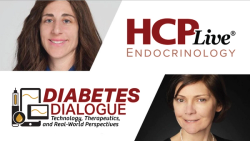
OR WAIT null SECS
No Difference in Outcomes with Lower Glycemic Threshold for Diagnosing Gestational Diabetes
Despite increasing the rate of diagnoses and healthcare utilization, the GEMS study found a lower glycemic criterion for diagnosis of gestational diabetes was not associated with a reduced risk of negative outcomes for mother and offspring.
Results of a randomized trial comparing the use of lower and higher glycemic criteria groups to diagnose gestational diabetes has returned mixed results.
Named the GEMS trial, results of the study indicate use of the lower glycemic threshold led to more diagnoses of gestational diabetes, which led to greater use of healthcare services, but was not associated with a lower risk of adverse events or delivering a large-for-gestational-age infant.
“Use of the lower glycemic criteria, as expected, led to a higher percentage of women receiving a diagnosis of gestational diabetes than use of the higher glycemic criteria; therefore, use of health services, which included induction of labor, care for diabetes, pharmacotherapy for blood glucose control, and treatment for neonatal hypoglycemia, was greater in the lower-glycemic-criteria group,” wrote investigators. “Overall, the risks of giving birth to a large-for-gestational age infant and of other infant or maternal complications were not lower with the lower glycemic criteria than with the higher glycemic criteria.”
Led by a team of investigators from New Zealand, the Gestational Diabetes Mellitus Trial of Diagnostic Detection Thresholds (GEMS) randomized women with a singleton pregnancy receiving antenatal care who had a 75-gram oral glucose-tolerance test (OGTT) for gestational diabetes at 24-32 weeks to be evaluated using a lower or higher glycemic criteria for diagnosis of gestational diabetes. With financial support from the Health Research Council of New Zealand and other New Zealand-based institutions, the trial’s primary outcome was the birth of an infant who was large for gestational age, which was denied as a birth weight above the 90th percentile according to Fen-World Health Organization standards. The trial’s secondary outcomes of interest included multiple maternal and infant health outcomes, including induction of labor, use of health services, use of pharmacologic agents, and risk of adverse events.
For the purpose of analysis, the lower glycemic criterion was a fasting plasma glucose level of at least 92 mg/dL(≥5.1 mmol/L), a 1-hour level of at least 180 mg/dL (≥10.0 mmol/L), or a 2-hour level of at least 153 mg/dL (≥8.5 mmol/L) and the higher glycemic criterion was a fasting plasma glucose level of at least 99 mg/dL (≥5.5 mmol/L) or a 2-hour level of at least 162 mg per deciliter (≥9.0 mmol/L).
With recruitment beginning in April 2015 and lasting through August 2020, investors screened 5662 women for eligibility and 4061 underwent randomizations into the trial. After randomization, 2022 were assigned to the lower glycemic criteria and 2039 were assigned to the higher glycemic criteria. Of the 4061 who underwent randomization, 4050 women and their infants completed follow-up to the time of hospital discharge after birth. No significant differences were observed for the characteristics of women included in each arm of the trial.
Overall, 15.3% in the lower glycemic criteria group and 6.1% in the higher glycemic criteria group received a diagnosis of gestational diabetes. Of the 2019 offspring born to women in the lower glycemic criteria group, 8.8% were large for gestational age compared to 8.9% of the 2031 infants born to women in the higher glycemic criteria group (aRR, 0.98 [95% CI, 0.80-1.19]; P=.82). Further analysis demonstrated induction of labor, use of health services, use of pharmacologic agents, and neonatal hypoglycemia occurred more commonly in the lower glycemic criteria group than among the higher glycemic group.
In a subgroup of women who had OGTT results fall between the lower and higher glycemic criteria, those treated for gestational diabetes experienced improved maternal and infant health benefits, including fewer large-for-gestational-age infant, compared with those who were not treated for gestational diabetes. Among the additional findings highlighted by investigators was an increase in infants with hypoglycemia warranting treatment in the lower glycemic criteria group, which investigators suggested was likely due to the higher percentage of infants born to a mother with a diagnosis of gestational diabetes that were identified as requiring additional screening.
In a related editorial, Michael Greene, MD, of Department of Obstetrics and Gynecology, Harvard Medical School, summarized the results of the study and reflected on the additional research needed to identify the optimal approach to diagnosing gestational diabetes with the aim of improving outcomes for mother and child.
“Ultimately, diagnosing gestational diabetes in more women through the use of the lower glycemic criteria in this trial neither improved nor worsened outcomes for the mothers or their babies. The perfect line for diagnosing gestational diabetes has yet to be drawn,” Greene wrote.
This study, “Lower versus Higher Glycemic Criteria for Diagnosis of Gestational Diabetes,” was published in the New England Journal of Medicine.

